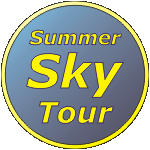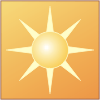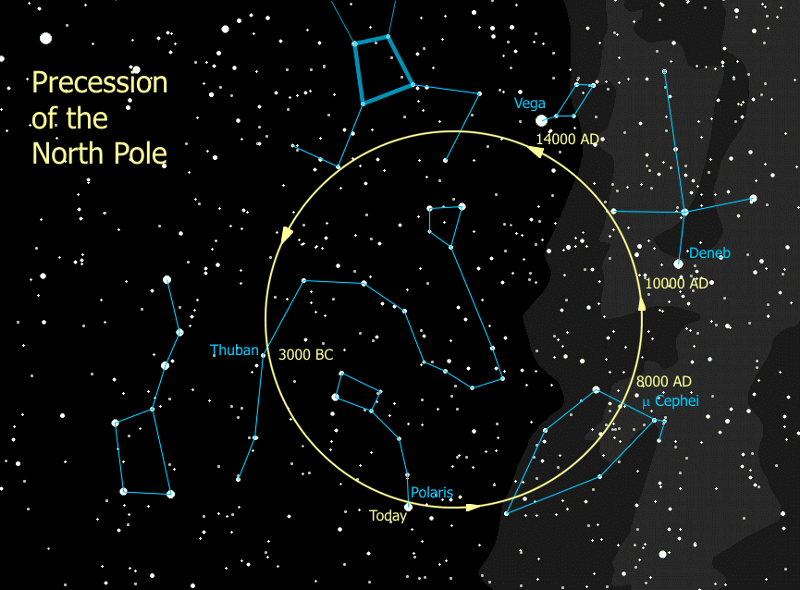Stargazing

|
The Constellation Draco |

|
- Hercules is pictured (upside down) in a kneeling position, on one knee,
with his foot on the head of Draco the Dragon. {Trace out Draco.} Draco
starts off with two bright yellow eyes (actually one's yellow, one's
orange), and then winds around the little dipper with its tail between
the two dippers. The lop-sided square that forms his head is known as
"The Lozenge", and makes a very distinctive shape that helps you to
recognize Draco. Who's got the binoculars? Use them to find Draco's
eyes, then go down to find the next star in the Lozenge closest to the
eyes -- ν (nu) Draconis. Notice anything?
That's right, it's a double star, and a very neat one in binoculars,
tight together and exactly equal in brightness.

- The third star from the end of Draco's tail has its own name - Thuban -
even though it's not very bright. What makes Thuban special is that it
once was the North Star - about 5,000 years ago. Our North Pole is
actually moving through the sky because the earth wobbles on its axis,
just like a top does, particularly just before it falls over (no - the
earth is not about to fall over). With the axis wobbling like that,
the North Pole is tracing a circle in the sky - it just happens to be
passing by Polaris right now.
It is about a degree away from our North Star now and will get about a half degree closer, then will start moving away as it continues on its circle through the sky. That circle will take it almost exactly right down the center of Cepheus, past Deneb in Cygnus, past Vega in Lyra, through Hercules leg and right by his knee, then down past Thuban and back to Polaris.

And speaking of coming full circle, we've come full circle. We started with the polar constellations and here we are, back at the polar constellations. Our summer sky tour is completed. For you die-hard stalwarts with a particularly high resistance to the night chill, we will continue on to learn a few additional constellations, and find a few additional interesting objects.
The hangers-on and those of us who still feel like playing with our telescopes will track down the following, and possibly other, items of interest. Also some of these get picked up during the tour, depending on where the questions, requests, and conversation end up going.
- Serpens - Eagle Nebula M16 and Swan Nebula M17
- Capricornus -- sometimes to try to find the planets Neptune/Uranus
- Pegasus and M15
- Andromeda and the Andromeda Galaxy M31
- Globular Clusters M22 and M28 in Sagittarius
 |
 |
| Back to Hercules | Go to Index |
Questions
Your questions and comments regarding the Stargazing section are welcome.
You can e-mail the author, Randy Culp for inquiries,
suggestions, new ideas or just to chat.
Updated 18 July 2023
